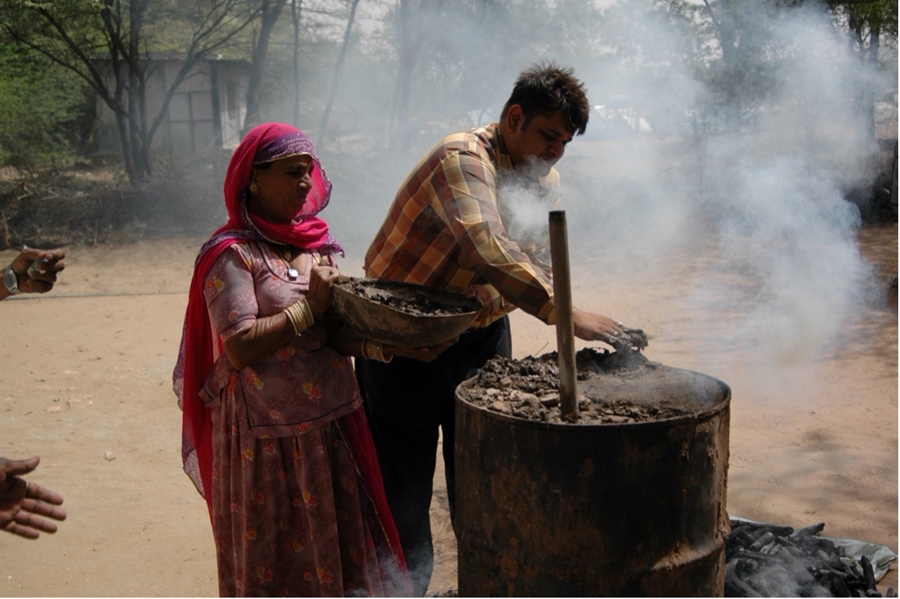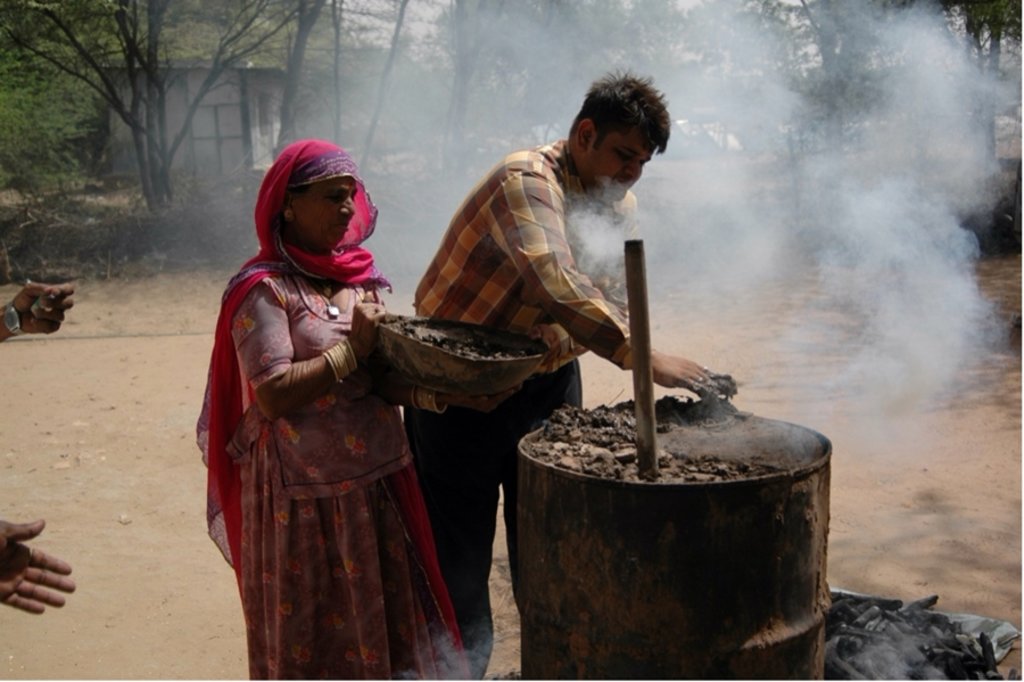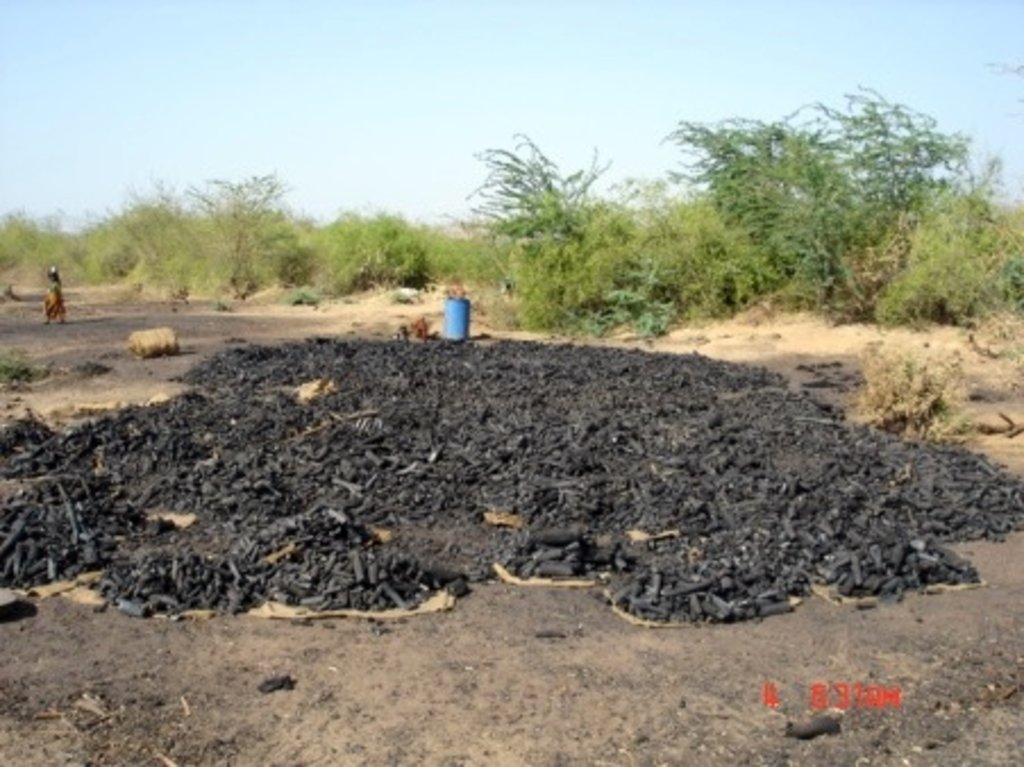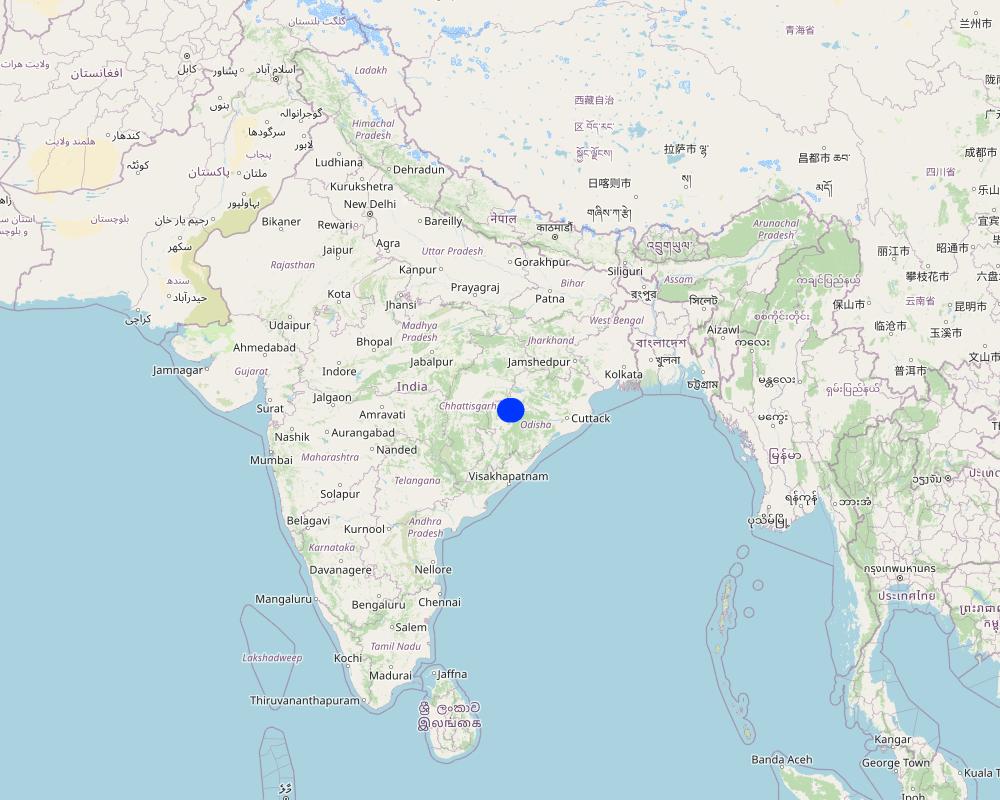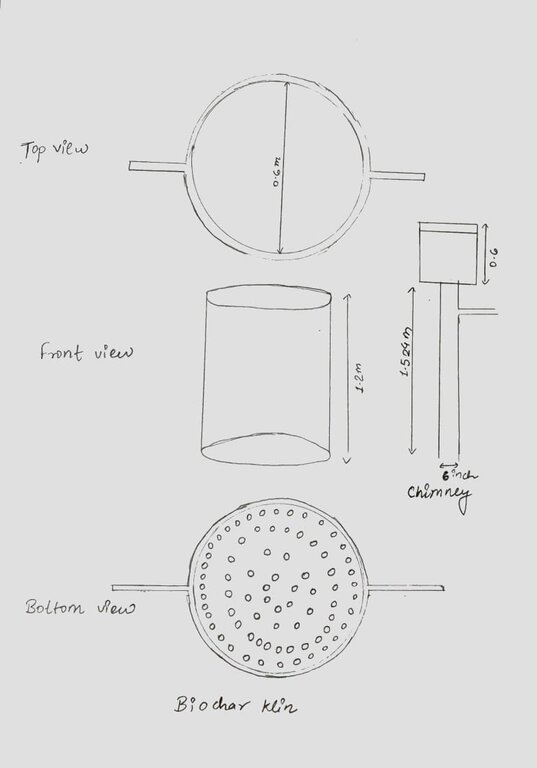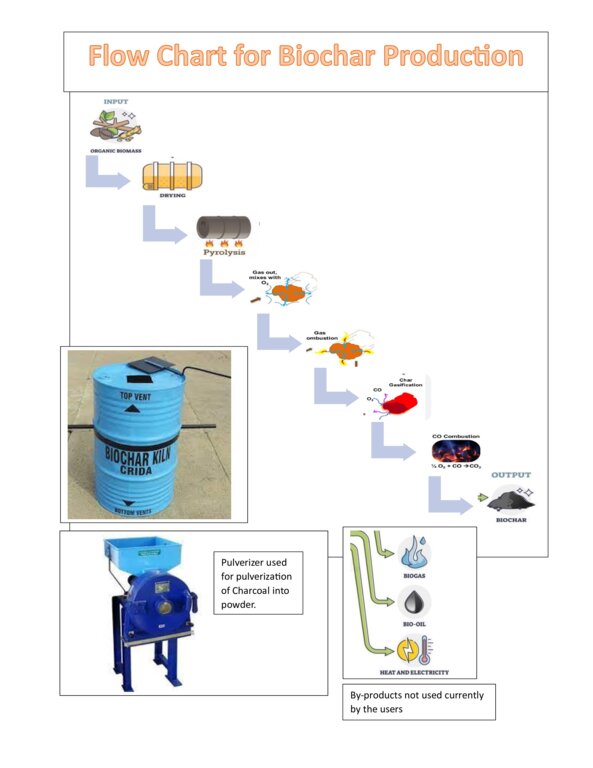Sustainable Biochar Production Through Agroforestry Systems And Its Application [印度]
- 创建:
- 更新:
- 编制者: Santosh Gupta
- 编辑者: Kim Arora, Stephanie Jaquet, Tabitha Nekesa, Ahmadou Gaye, Siagbé Golli
- 审查者: Udo Höggel, Sally Bunning
technologies_6735 - 印度
查看章节
全部展开 全部收起1. 一般信息
1.2 参与该技术评估和文件编制的资源人员和机构的联系方式
有助于对技术进行记录/评估的项目名称(如相关)
Soil protection and rehabilitation for food security (ProSo(i)l)有助于对技术进行记录/评估的机构名称(如相关)
Deutsche Gesellschaft für Internationale Zusammenarbeit (GIZ) - 德国有助于对技术进行记录/评估的机构名称(如相关)
International Centre for Research in Agroforestry (ICRAF) - 肯尼亚有助于对技术进行记录/评估的机构名称(如相关)
Ecociate Consultants (Ecociate Consultants) - 印度1.3 关于使用通过WOCAT记录的数据的条件
编制者和关键资源人员接受有关使用通过WOCAT记录数据的条件。:
是
1.4 所述技术的可持续性声明
这里所描述的技术在土地退化方面是否存在问题,导致无法被认为是一种可持续的土地管理技术?:
否
注释:
The application of biochar to the soil is a technology that can prevent or reduce land degradation by improving soil health through the addition of organic matter, increase soil fertility and the water retention capacity of soils.
1.5 参考关于SLM方法(使用WOCAT记录的SLM方法)的调查问卷

Developing professional standards in the installation, maintenance and … [马里]
Ensure the sustainability of schemes and continuity of production, and reduce production costs
- 编制者: Dieter Nill
2. SLM技术的说明
2.1 技术简介
技术定义:
Biochar is a carbon-rich, solid material derived from a wide range of biomass or organic waste through a thermochemical method. It is an organic charcoal material that is the final product of pyrolysis, or high-temperature burning of agricultural biomass without oxygen. Surplus crop residues, agricultural waste, and wood from sustainable sources are used as feedstock (raw material). Such biochar production is linked with agroforestry plantation and agriculture to improve soil health and ensuring sustainable feedstock availability.
2.2 技术的详细说明
说明:
Introduction and Background
Intensive cropping systems coupled with monocropping and high usage of synthetic fertilizers have led to the degradation of soils and depletion of nutrients directly affecting agricultural productivity and farmers' income. Farmers in the Balangir district of Odisha are facing similar challenges. To address these issues and promote sustainable farming practices, a biochar production initiative was introduced by utilizing crop residues and waste material from forests to produce biochar, a carbon-rich material that enhances soil fertility and soil structure. The initiative is a part of the Pro-Soil Project of Deutsche Gesellschaft für Internationale Zusammenarbeit (GIZ), India and implemented by the International Centre for Research in Agroforestry (ICRAF). The technology (a kiln for biochar production) and technical inputs for biochar production were sourced from the Indian Institute of Soil Science, Bhopal.
Biochar is a type of charcoal produced from biomass like agricultural or forest waste or organic materials through a process called pyrolysis. The application of sustainable biochar technology in agroforestry systems can lead to better soil structure, increased water retention, reduced nutrient leaching, and improved crop yields. Moreover, it aids in mitigating greenhouse gas emissions by locking carbon into soil for an extended period.
In the project region farmers used crop residues such as rice straw, wheat straw and residue of other crops along with non-usable biomass from local forests, such as branches, twigs, and leaves, to supplement the feedstock for the pyrolysis. Since the District has large forest areas, the availability of forest waste is no problem. The biochar produced was applied into existing crops fields as well as into agroforestry system. Aiming to promote agroforestry, the project promoted the integration of trees (both fruits and timber) and shrubs into existing agricultural practices. Agroforestry offers multiple benefits such as improved soil health, biodiversity, and carbon sequestration. When sustainable biochar production is integrated into these systems, it can create a sustainable cycle where agricultural waste is converted into biochar, which then enhances soil fertility and sequesters carbon when added back into the soil.
The project has actively involved women farmers, entrepreneurial youth, and farmers' groups in the collection, production and application process of biochar thus promoting community participation and creating awareness about the benefits of biochar.
Implementation
The biochar kiln technology, obtained from the Indian Institute of Soil Science, in Bhopal, is employed to convert biomass into biochar through pyrolysis. This technology ensures efficient and controlled production of high-quality biochar. The collected biomass undergoes a controlled pyrolysis process inside the biochar kiln, where it is burned in the relative absence of oxygen. Technical specialization during production includes kiln temperature control, feedstock preparation, and the management of pyrolysis gases to ensure efficient biochar production. This results in the conversion of biomass into biochar, also leaving behind bioenergy-rich gases. Quality control measures are implemented to ensure the production of biochar with optimal characteristics, including high carbon content, porosity, and stability.
The Biochar kiln used was designed with the aim to optimize temperature control and ensure efficient conversion of biomass. An efficient loading mechanism allows easy and controlled feeding of biomass into the kiln. This ensures a consistent flow of material during the pyrolysis process. Although local kilns are usually not equipped with temperature control mechanisms to regulate the pyrolysis temperature, the temperature in the kilns may alternatively be regulated through the rate of feeding biomass into the kilns. Such kilns usually have some safety features and proper ventilation so to prevent accidents.
To implement this technology the ICRAF conducted training sessions for farmers on the proper preparation and application of biochar. The trainings were focused on the following aspects:
-The collection and drying process for agriculture and forest waste
-The management of operations for the biochar kiln including the loading of raw material (feedstock) into the kiln, its burning, operation-timing, period check, volumes of raw material to be fed etc.
-Precautions to be taken during the process
-The quality check of prepared biochar charcoal and the process for pulverizing it
-Dosage recommendations for different crops as per local conditions
-The mixing of biochar with cow dung and cow urine before application
-Integration with existing farming practices and the long-term benefits of biochar on soil health
Impact and Knowledge Transfer
The biochar acts as a soil conditioner, enhancing water retention, nutrient availability, and microbial activity. The benefits and impacts on improved fertility, increased water retention, and reduced nutrient leaching, lead to higher crop yields and resilience against climate variability, carbon sequestration aids in reducing greenhouse gas emissions, contributing to global efforts to combat climate change, and utilizing agricultural residues reduces air pollution from open burning and provides a sustainable solution for organic waste disposal. Land users appreciated the enhanced soil productivity and environmental benefits brought by biochar. Overall, the Sustainable Biochar Production Technology represents a promising approach in sustainable agriculture and environmental stewardship.
The project team, in collaboration with local agricultural extension services and the Indian Institute of Soil Science, monitored the impact of biochar application on soil health parameters. This involved regular soil testing, crop yield assessments and feedback from participating farmers. In fact, they also measured the impact of biochar made from different feedstock (raw materials). Success stories were shared with neighboring communities, public stakeholders and researchers and encouraged the further adoption of sustainable soil management practices.
The biochar production initiative in the Balangir District of Odisha in India demonstrates a sustainable approach to addressing soil health issues using locally available resources. Through the collaboration between ICRAF and GIZ, this project not only improves soil fertility but also empowers local communities by providing them with sustainable solutions for agricultural challenges. The success of this intervention serves as a model for future initiatives aimed at promoting environmentally friendly and community-driven approaches to agriculture.
2.3 技术照片
2.4 技术视频
注释、简短说明:
https://www.youtube.com/watch?v=qHpIPVX2mR8&t=8s
位置:
Bhopal, MP
摄影师的名字:
ICAR-CIAE
2.5 已应用该技术的、本评估所涵盖的国家/地区/地点
国家:
印度
区域/州/省:
Odisha
具体说明该技术的分布:
- 适用于特定场所/集中在较小区域
技术现场是否位于永久保护区?:
否
Map
×2.6 实施日期
注明实施年份:
2021
2.7 技术介绍
详细说明该技术是如何引入的:
- 在实验/研究期间
- 通过项目/外部干预
注释(项目类型等):
Piloting best practices to produce biochar using diverse feedstock and its application
3. SLM技术的分类
3.1 该技术的主要目的
- 改良生产
- 减少、预防、恢复土地退化
- 保护生态系统
- 保持/提高生物多样性
- 适应气候变化/极端天气及其影响
- 创造有益的经济影响
3.2 应用该技术的当前土地利用类型
同一土地单元内混合使用的土地::
否

农田
- 一年一作
- 乔木与灌木的种植
年作 - 具体指明作物:
- 谷类 - 小米
- 谷类 - 水稻(旱地)
乔木和灌木种植 - 指定作物:
- 饲料树木(朱缨花属、银合欢、前庭草等)
- 水果、其他
每年的生长季节数:
- 2
具体说明:
Mostly farmers are cultivating during the monsoon season as these are the rainfed farmers. Some farmers with irrigation facilities are cultivating in winter season as well
采用间作制度了吗?:
是
如果是,说明哪些作物是间作的:
Millets and other cereals
采用轮作制度了吗?:
是
如果是,请具体说明:
Cereals, Pulses, Fodder crops

森林/林地
- (半天然)天然森林/林地
(半天然)天然森林/林地:具体说明管理类型:
- 清除枯木/剪枝
以上的树木是落叶树还是常绿树?:
- 混合落叶或常绿
产品和服务:
- 木材
- 薪材
- 水果和坚果
- 放牧/啃牧

定居点、基础设施
- 定居点、建筑物
3.3 由于技术的实施,土地使用是否发生了变化?
由于技术的实施,土地使用是否发生了变化?:
- 否(继续问题3.4)
3.4 供水
该技术所应用土地的供水:
- 混合雨水灌溉
注释:
Most farmers are cultivating in rainfed conditions while some also have irrigation facilities
3.5 该技术所属的SLM组
- 改良的地面/植被覆盖
- 集水
- 废物管理/废水管理
3.6 包含该技术的可持续土地管理措施

农艺措施
- A1:植被和土壤覆盖层
- A2:有机质/土壤肥力
- A3:土壤表面处理
- A6:残株管理

植物措施
- V4:更换或清除外来/入侵物种
- V5:其它

管理措施
- M6:废物管理(回收、再利用或减少)

其它措施
具体说明:
Climate resilient soil management by application of biochar using varied feedstock (rwa material) generated through agroforestry
3.7 该技术强调的主要土地退化类型

土壤水蚀
- Wt:表土流失/地表侵蚀

物理性土壤退化
- Ps:有机土壤沉降,土壤沉降

生物性退化
- Bl:土壤寿命损失
3.8 防止、减少或恢复土地退化
具体数量名该技术与土地退化有关的目标:
- 减少土地退化
- 修复/恢复严重退化的土地
4. 技术规范、实施活动、投入和成本
4.1 该技术的技术图纸
技术规范(与技术图纸相关):
The single barrel biochar klin was developed by the Indian Institute of Soil Sciences in Bhopal (IISS). The Kiln had already been designed and commercialised by the IISS. Land users can buy a metallic kiln unit from the IISS or get it fabricated from local fabricators based on the design specifications suggested in the drawing.
作者:
Payal Dewangan
日期:
12/07/2023
技术规范(与技术图纸相关):
The flowchart provides a step by step guide for biochar production in the project area by land users
作者:
Payal and Santosh
日期:
20/11/2023
4.2 有关投入和成本计算的一般信息
具体说明成本和投入是如何计算的:
- 每个技术单元
指定单位:
200 L capacity
指定单位面积(如相关):
Litre
其它/国家货币(具体说明):
INR
如相关,注明美元与当地货币的汇率(例如1美元=79.9巴西雷亚尔):1美元=:
80.0
注明雇用劳工的每日平均工资成本:
204 Rupees
4.3 技术建立活动
| 活动 | 时间(季度) | |
|---|---|---|
| 1. | Purchase of biochar kiln unit | Can be done any time during the year but need to be ready before the month of September |
| 2. | Purchase of pulveriser | Need to be purchased once and before the start of biochar production |
注释:
Both biochar kiln and pulveriser are fixed investments and can last up to 5 years
4.4 技术建立所需要的费用和投入
| 对投入进行具体说明 | 单位 | 数量 | 单位成本 | 每项投入的总成本 | 土地使用者承担的成本% | |
|---|---|---|---|---|---|---|
| 设备 | Biochar Klin | Rs. | 1.0 | 7000.0 | 7000.0 | |
| 设备 | Pulvariser unit | Rs. | 1.0 | 20000.0 | 20000.0 | |
| 技术建立所需总成本 | 27000.0 | |||||
| 技术建立总成本,美元 | 337.5 | |||||
如果土地使用者负担的费用少于100%,请注明由谁负担其余费用:
The project paid towards the fixed investment costs of biochar kiln and pulverizier unit
4.5 维护/经常性活动
| 活动 | 时间/频率 | |
|---|---|---|
| 1. | Collecting the crop residues and forest waste | Needs to be collected and dried before the start of biochar production unit (September and June) |
| 2. | Preparation of Biochar | Before the sowing of Rabi (winter) and Kharif (summer) seasons (Months of September/October and June/July) |
| 3. | Application of biochar in the field | During the cropping season |
注释:
These activities may vary based on the cropping pattern and farmers' need of biochar application
4.6 维护/经常性活动所需要的费用和投入(每年)
| 对投入进行具体说明 | 单位 | 数量 | 单位成本 | 每项投入的总成本 | 土地使用者承担的成本% | |
|---|---|---|---|---|---|---|
| 劳动力 | Preparation of biochar | Person-day | 2.0 | 200.0 | 400.0 | 100.0 |
| 劳动力 | Application of biochar in the field | Person-day | 1.0 | 200.0 | 200.0 | 100.0 |
| 肥料和杀菌剂 | Farmyard manure | Rs. | 20.0 | 5.0 | 100.0 | 100.0 |
| 肥料和杀菌剂 | Fertilizer | Rs. | 50.0 | 7.0 | 350.0 | 100.0 |
| 技术维护所需总成本 | 1050.0 | |||||
| 技术维护总成本,美元 | 13.13 | |||||
注释:
The application of biochar was practiced by land users twice in a year, before sowing kharif and rabi crops. The amount of maintenance activities of the technology is count double for a year as farmers are practicing the biochar technology for two seasons in a year.
4.7 影响成本的最重要因素
描述影响成本的最决定性因素:
The investment towards the purchase of the kiln- and the pulveriser unit. In the documented project, the investment costs were borne by the project. Therefore, smallholder farmers may find it difficult to purchase the hardware units of kiln and pulveriser, given such investment costs.
5. 自然和人文环境
5.1 气候
年降雨量
- < 250毫米
- 251-500毫米
- 501-750毫米
- 751-1,000毫米
- 1,001-1,500毫米
- 1,501-2,000毫米
- 2,001-3,000毫米
- 3,001-4,000毫米
- > 4,000毫米
指定年平均降雨量(若已知),单位为mm:
1288.00
注明所考虑的参考气象站名称:
Bhubaneshwar, Odisha
农业气候带
- 半湿润
The District is located under the West Central Table Land Agro Climatic Zone characterized by hot and sub-humid climate
5.2 地形
平均坡度:
- 水平(0-2%)
- 缓降(3-5%)
- 平缓(6-10%)
- 滚坡(11-15%)
- 崎岖(16-30%)
- 陡峭(31-60%)
- 非常陡峭(>60%)
地形:
- 高原/平原
- 山脊
- 山坡
- 山地斜坡
- 麓坡
- 谷底
垂直分布带:
- 0-100 m a.s.l.
- 101-500 m a.s.l.
- 501-1,000 m a.s.l.
- 1,001-1,500 m a.s.l.
- 1,501-2,000 m a.s.l.
- 2,001-2,500 m a.s.l.
- 2,501-3,000 m a.s.l.
- 3,001-4,000 m a.s.l.
- > 4,000 m a.s.l.
说明该技术是否专门应用于:
- 不相关
关于地形的注释和进一步规范:
Balangir District is divided into four Agro-Ecological situations (AES) and characterized by a hot dry summer and highly erratic rainfall distribution of south-west monsoon rains, i.e., (i) plain land irrigated, (ii) plain land rainfed (iii) undulating plain drought-prone and (iv) undulating sub-mountainous tract rainfed.
The altitude of the Bolangir district is 207 masl.
5.3 土壤
平均土层深度:
- 非常浅(0-20厘米)
- 浅(21-50厘米)
- 中等深度(51-80厘米)
- 深(81-120厘米)
- 非常深(> 120厘米)
土壤质地(表土):
- 粗粒/轻(砂质)
- 细粒/重质(粘土)
土壤质地(地表以下> 20厘米):
- 粗粒/轻(砂质)
- 细粒/重质(粘土)
表土有机质:
- 低(<1%)
如有可能,附上完整的土壤描述或具体说明可用的信息,例如土壤类型、土壤酸碱度、阳离子交换能力、氮、盐度等。:
Mixed red and yellow soils occur as catenary associations in undulating and rolling terrains which differ in depth, texture, and color. Red and yellow soils are moderately shallow in depth and coarse-textured. Upland soils are shallower and lighter in texture than low-land soils.
Red and black soils are light to medium textured having neutral pH. These soils occur in mixed forms of both red & black soil together in which black soils occur in patches within the predominant red soils.
Black soils are mostly found in Puintala Block and in some parts of Loisingha Block. The soils are heavier in texture having clay content more than 30%. Clay minerals are predominant with smectites due to which deep cracks are seen to develop during summer.
Laterite soils are generally distributed in a few limited patches in the Balangir District. These soils are loamy sand to sandy loam in the surface having a hard clay pan in the subsoil. Crusting is a problem in upland literite.
Brown forest soils are mostly found in Khaprakhol, Tureikela, Bangomunda, Titilagarh, Saintala, and Gudvella Block. These soils are brown to grey-brown in color, light textured, and acidic in reaction.
5.4 水资源可用性和质量
地下水位表:
5-50米
地表水的可用性:
好
水质(未处理):
不良饮用水(需要处理)
水质请参考::
地下水和地表水
水的盐度有问题吗?:
是
具体说明:
Balangir District falls within the Western Plateau and Hills Zone of Odisha, characterized by a semi-arid climate. The agro-climatic conditions include hot summers, limited rainfall, and erratic monsoons, which pose challenges for agriculture due to water scarcity. In many regions of Odisha, including Balangir, water salinity is a significant concern, especially in areas relying on groundwater sources.
该区域正在发生洪水吗?:
否
关于水质和水量的注释和进一步规范:
The groundwater level at 3 meters below ground level in 2019 indicates water table that lies within 3-5 meters below ground level (m bgl) or less is considered shallow. This level often indicates good accessibility to groundwater, making it relatively easier for extraction using shallow wells or hand pumps.
5.5 生物多样性
物种多样性:
- 高
栖息地多样性:
- 高
关于生物多样性的注释和进一步规范:
The Odisha Government has declared the Gandhamardan Hill Range in Bargarh and Balangir Districts a Biodiversity Heritage Site (BHS).
5.6 应用该技术的土地使用者的特征
生产系统的市场定位:
- 生计(自给)
非农收入:
- 低于全部收入的10%
相对财富水平:
- 贫瘠
个人或集体:
- 个人/家庭
- 团体/社区
机械化水平:
- 手工作业
- 畜力牵引
性别:
- 女人
- 男人
土地使用者的年龄:
- 青年人
- 中年人
说明土地使用者的其他有关特征:
There are a number of women self help groups and farmer producer organisations being formed in the district as part of Government programs
5.7 应用该技术的土地使用者使用的平均土地面积
- < 0.5 公顷
- 0.5-1 公顷
- 1-2 公顷
- 2-5公顷
- 5-15公顷
- 15-50公顷
- 50-100公顷
- 100-500公顷
- 500-1,000公顷
- 1,000-10,000公顷
- > 10,000公顷
这被认为是小规模、中规模还是大规模的(参照当地实际情况)?:
- 小规模的
5.8 土地所有权、土地使用权和水使用权
土地所有权:
- 个人,有命名
土地使用权:
- 个人
用水权:
- 社区(有组织)
- 个人
土地使用权是否基于传统的法律制度?:
否
注释:
The majority of the farmers in the district are smallholder farmers with agriculture being mostly rained, except some areas with irrigation facilities from the nearby dam
5.9 进入服务和基础设施的通道
健康:
- 贫瘠
- 适度的
- 好
教育:
- 贫瘠
- 适度的
- 好
技术援助:
- 贫瘠
- 适度的
- 好
就业(例如非农):
- 贫瘠
- 适度的
- 好
市场:
- 贫瘠
- 适度的
- 好
能源:
- 贫瘠
- 适度的
- 好
道路和交通:
- 贫瘠
- 适度的
- 好
饮用水和卫生设施:
- 贫瘠
- 适度的
- 好
金融服务:
- 贫瘠
- 适度的
- 好
注释:
The district is located in the interior parts of eastern India and considered as a backward district with poor access to infrastructure and other facilities
6. 影响和结论性说明
6.1 该技术的现场影响
社会经济效应
生产
作物生产
注释/具体说明:
For Wood Biochar or Wood Coconut Husk Biochar (WCB), or Crop Residue Biochar (CRB) the highest grain yield of the crop was recorded with the highest dose of biochar, fertilizer, and manure application. Also, it's application significantly improved the straw yield
作物质量
注释/具体说明:
The application of Wood Biochar or Wood Coconut Husk Biochar (WCB), or Crop Residue Biochar (CRB) with manure also significantly improved the quality of the crop
饲料生产
注释/具体说明:
It was found with significantly improved straw yield the availability of fodder for the livestock also increased
饲料质量
注释/具体说明:
It was recorded that the quality of the crop also the quality of the straw also improved.
生产故障风险
注释/具体说明:
It was observed that the crop in which the application of biochar was with the manure and fertilizer, the crop had better adaptation and standing properties in comparison to another crop without the application of biochar.
土地管理
收入和成本
农业收入
注释/具体说明:
The yield for the crop in which application was done was increased which led to an increase in income
社会文化影响
食品安全/自给自足
生态影响
水循环/径流
水的回收/收集
注释/具体说明:
Water retention from the soil increased because of the increase in soil organic matter and carbon content
地表径流
注释/具体说明:
The water holding capacity of the water increased leading to less surface runoff from the field.
蒸发
土壤
土壤水分
注释/具体说明:
With an increase in soil organic matter and improved soil texture the soil moisture increased
土壤流失
注释/具体说明:
The semi-arid climate and limited rainfall, combined with sporadic and intense monsoons, can lead to soil erosion. When rainfall does occur, it can cause rapid runoff, carrying away the topsoil due to the lack of vegetation cover or inadequate soil conservation measures.
养分循环/补给
注释/具体说明:
The application of biochar with manure and fertilizers not only increased the nutrients in the soil but also increased the nutrient uptake of plants from the soil.
盐度
注释/具体说明:
Biochar can act as a soil amendment to moderate soil pH depending on the initial pH level. Scientifically, biochar tends to be pH neutral, so its impact on soil pH depends on the existing soil condition. The impact of biochar on pH is often gradual and depends on various factors like the type and composition of biochar, soil characteristics and environmental conditions. Biochar acts more as a buffer, stabilizing soil pH over time rather than making drastic immediate changes.
土壤有机物/地下C
生物多样性:植被、动物
植被覆盖
注释/具体说明:
The plant biomass as well as the vegetative growth of the plant showed a significant positive reaction to the biochar application on crops
生物量/地上C
植物多样性
害虫/疾病控制
注释/具体说明:
Resistance of the crop increases with better uptake of K from the soil. Plants become more resistant to disease and pests.
减少气候和灾害风险
碳和温室气体的排放
对现场影响的评估(测量)进行具体说明:
In the context of regions like Balangir, where salinity and soil loss are concerns, biochar's ability to improve soil structure and fertility without altering pH drastically could be beneficial. It helps mitigate soil erosion by enhancing soil health and resilience, thus contributing to sustainable agriculture practices in these challenging environments.
6.3 技术对渐变气候以及与气候相关的极端情况/灾害的暴露和敏感性(土地使用者认为的极端情况/灾害)
渐变气候
渐变气候
| 季节 | 增加或减少 | 该技术是如何应对的? | |
|---|---|---|---|
| 年温度 | 增加 | 适度 | |
| 季节性温度 | 夏季 | 增加 | 适度 |
| 年降雨量 | 减少 | 好 | |
| 季雨量 | 湿季/雨季 | 减少 | 适度 |
气候有关的极端情况(灾害)
气候灾害
| 该技术是如何应对的? | |
|---|---|
| 干旱 | 适度 |
注释:
Overall biochar improves the soil health and helps soil to maintain the moisture thus it is better suited to some of the climatic conditions such as low rainfall, delayed rains etc. However in case of extreme climatic conditions, technology alone may not mitigate the impact.
6.4 成本效益分析
技术收益与技术建立成本相比如何(从土地使用者的角度看)?
短期回报:
积极
长期回报:
非常积极
技术收益与技术维护成本/经常性成本相比如何(从土地使用者的角度看)?
短期回报:
非常积极
长期回报:
非常积极
注释:
The benefits of technology to soil health, crop productivity and crop quality is much higher than the cost of establishment and maintenance
6.5 技术采用
- 单例/实验
如若可行,进行量化(住户数量和/或覆盖面积):
100
在所有采用这项技术的人当中,有多少人是自发的,即未获得任何物质奖励/付款?:
- 0-10%
注释:
It was mostly done as part of the PRO-SOIL PROJECT
6.6 适应
最近是否对该技术进行了修改以适应不断变化的条件?:
是
若是,说明它适应了哪些变化的条件:
- 劳动力可用性(例如,由于迁移)
具体说明技术的适应性(设计、材料/品种等):
Refinements in pyrolysis methods and technologies to produce biochar with specific characteristics suited to diverse soil types and climate conditions. This includes adjusting temperature, duration, and feedstock to optimize biochar properties like porosity and water retention capacity. Innovations in application techniques to improve the efficiency and effectiveness of biochar incorporation into agricultural systems. This involves exploring precision application methods, such as localized placement or mixing with organic amendments, to ensure better distribution and utilization of biochar in the root zone. Emphasis on integrating biochar technology into climate-smart agricultural practices, focusing on sustainable intensification while adapting to changing climatic conditions. This involves promoting practices that enhance resilience to drought, water conservation and soil fertility improvement.
6.7 该技术的优点/长处/机会
| 土地使用者眼中的长处/优势/机会 |
|---|
| The soil moisture, soil texture, water retention and water-holding capacity of the soil increases. The uptake of nutrients increases which leads to less application of fertilizers in the field |
| There was an increase in crop yield, straw yield, vegetative mass growth, more grains or fruits per plant, and fewer pests & disease attacks on the plants were noticed |
| The better use of crop residue from the field increase the soil fertility and promoted better crop growth |
| 编制者或其他关键资源人员认为的长处/优势/机会 |
|---|
| The use of biochar helps to combat the climate crisis by sequestering atmospheric carbon into soil as well as processing agricultural and other waste into useful clean energy |
| The application of biochar significantly changes the soil’s properties (texture, porosity, bulk density, particle density, surface area, pore size distribution, cation exchange capacity, pH, and water-holding capacity) which, directly influence plant growth |
| High porosity and a large surface area of biochar provide space for micro-organisms that are beneficial for the soil and help in binding important anions and cations, improving soil health and enhancing crop productivity |
| Reduced nitrous oxide and methane emissions when biochar is applied to the soil |
6.8 技术的弱点/缺点/风险及其克服方法
| 土地使用者认为的弱点/缺点/风险 | 如何克服它们? |
|---|---|
| Need large quantities of wood and crop residue for biochar production on a larger scale |
A better planning for crop residue management and access to communities to collect forest waste from forest can easily address this problem Exploring alternative biomass sources like agricultural residues, crop waste, or dedicated energy crops can reduce reliance on wood or coconut shells, promoting sustainable sourcing. Also, advancements in pyrolysis technologies to optimize biochar production from smaller quantities of biomass, improving efficiency and reducing the overall demand. |
| Do not have knowledge about how this biochar can be sold in the market for additional income |
Creating more awareness among the farmers about biochar will create a market demand for it. Conducting market assessments and creating awareness among potential buyers about the benefits of biochar for soil improvement, carbon sequestration, and agricultural productivity. Exploring the development of value-added products or applications derived from biochar, such as soil amendments, filtration systems, or compost blends, to diversify market opportunities. |
| 编制者或其他关键资源人员认为的弱点/缺点/风险 | 如何克服它们? |
|---|---|
| The availability of suitable wood and coconut for biochar production can be limited, and there may be competition between biochar production and other uses of biomass, such as food and fuel production | The innovation in technology where biochar can be produced with lesser amount of feedstock will be a great solution |
| If not managed sustainably, the production of biomass feedstock for biochar can lead to deforestation or the conversion of natural ecosystems into monoculture plantations, which can have negative ecological consequences |
The promotion of agro-forestry is important to ensure the availability of feed stock while also ensuring the increased coverage of forest. The training of land users and other stakeholders around sustainable biochar production. |
7. 参考和链接
7.1 信息的方法/来源
- 与土地使用者的访谈
4
- 与SLM专业人员/专家的访谈
3
- 根据报告和其他现有文档进行编译
5
(现场)数据是什么时候汇编的?:
07/07/2023
7.2 参考可用出版物
标题、作者、年份、ISBN:
IBI publication at International Biochar Initiative
可以从哪里获得?成本如何?
https://biochar-international.org/resources/ibi-publications/
7.3 链接到网络上的相关信息
标题/说明:
About Balangir District
URL:
https://balangir.nic.in/about-district/
标题/说明:
Water Resources of Balangir District (Minor Irrigation Division, Balangir)
URL:
https://balangir.nic.in/water-resources/
标题/说明:
Senior Geologist, Ground Water Survey & Investigation Division, Balangir
URL:
https://www.rtiodisha.gov.in/Pages/printAllManual/office_id:2710/lang:
7.4 一般注释
This documentation not only follows the land user interview findings but also follows the results mentioned in the internal report after the experimentation
链接和模块
全部展开 全部收起链接

Developing professional standards in the installation, maintenance and … [马里]
Ensure the sustainability of schemes and continuity of production, and reduce production costs
- 编制者: Dieter Nill
模块
无模块


